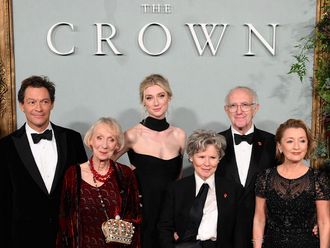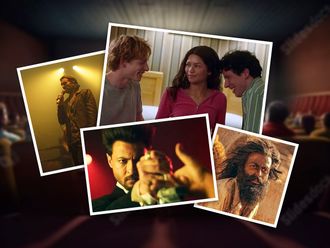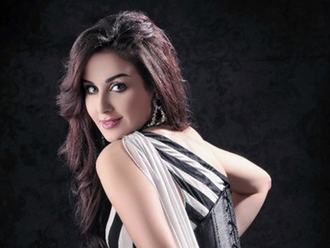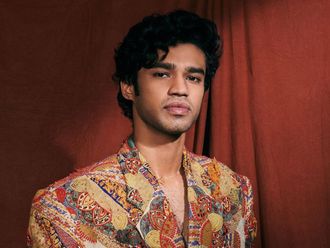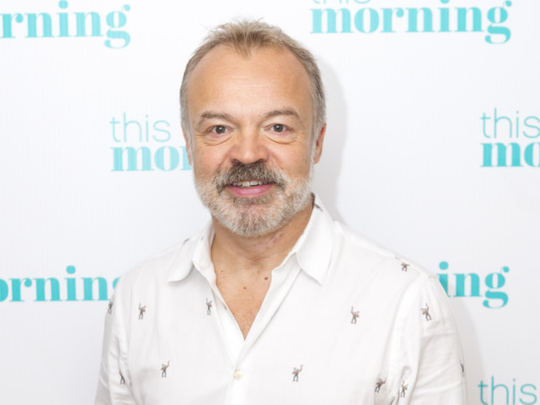
On the eve of his new series, Graham Norton is warming up the studio audience with a joke about a trade unionist at the Labour conference. Tosh McDonald does, you have to hand it to Norton, look exactly like the MP for Mordor. But Norton cannot be evaluated on a joke-by-joke basis. He is more than a comedian. “He’s not just good,” says Graham Stuart, his business partner since the very start of his talk-show days. “He’s phenomenal.”
Ask people why they like him and it’s like asking why they like otters or fried eggs. What kind of freak would say that? Who wouldn’t like him?
The corridors of The Graham Norton Show are festooned with stills of seminal moments like the Will Smith Fresh Prince rap watched over 50 million times (for impact, nothing will match Chris O’Dowd swallowing a fly, but the rapping was more photogenic.) Backstage, make-up artists sit unoccupied because all the guests arrive in full cake. The green room is full of sushi, but there are no sushi-takers. The stars are in some inner chamber, the holiest of holies, and everyone outside has a reverential air. This is regular telly, except with much more star power.
The show has been running on the BBC for just over a decade, having started on BBC2 and moved to BBC1 in 2009. It has altered very little since its 1998 Channel 4 incarnation, So Graham Norton. In those days, he had two unusual traits; innuendo that was actually funny (it can get very dutiful, laughing at double entendre — the sense that however weak it is, you have to reward the effort); and inclusiveness that was neither patronising nor cruel. It was originally devised for a late-night, post-pub audience, when executives noticed viewing figures build, particularly among women, particularly — or maybe just surprisingly — older women. As politicians flock to answer questions about biscuits on Mumsnet, so everybody flocks to the talk shows that older women show a preference for. This is because we are so often right.
Now, the guests often come on wielding a glass of wine, as if in defiance of their environment: “I’m not on a publicity tour. I’m at a dinner party.”
Mary Connor, the show’s publicist, insists there’s no artifice, that they come on with whatever they want. Tonight, Kate Winslet, Idris Elba and Chris Rock are, disappointingly, all on the water. But there’s a festive, champagne-cork symphony in the green room — the only noise in the space where unspecified fixers and minders watch closely, beset by rules. Mainly, you don’t talk. Off-screen, showbiz protocol prevails, business-like and discreet. But the on-screen vibe is something else entirely: it’s like watching stars in their own social habitat.
Having all the guests on the sofa at the same time is the programme’s most obvious and triumphant USP. It upends the hierarchy. The stars all shed their ‘sleb carapace, as they take responsibility for charming an even bigger celebrity. You watch the star become the fan — Emilia Clarke giggling next to Matt LeBlanc — and wonder whether it’s really real or just more shtick. But of course it’s real.
Tonight, Elba is trying to show off in front of Rock — a boyish, tryhard side of him for which no showreel on Earth exists. “All that’s really changed over the years,” says Connor rather ruefully, as if it makes her job a bit too easy, “is the calibre of the guests.”
It is relentlessly A-list: the only two stars Norton can think of he hasn’t got are Julia Roberts and Brad Pitt. It’s often the only British TV appearance an American star will make.
Both Norton and Stuart started their careers with a nerdy fascination with the US talk show (“it’s because he’s from the south of Ireland,” Stuart tells me, “all they used to watch was American TV”) and set out to borrow from the Letterman trope: the beauty on the sofa, the eager studio audience, the man behind the desk. But the beauty is never just beautiful on Graham Norton; everyone pulls their anecdotalising weight, nobody is just there as eye-candy.
And Norton is, of course — incomprehensibly from a feng shui point of view — in front of his desk. The studio audience is gigantic, 650 strong, with a waiting list long enough to fill it many times over at a moment’s notice, which gives it a comedy-club atmosphere. I’ve never seen anything that looks so shiny on the telly and so much like a Poundland window display in real life. Except for the red chair — the audience’s throne of judgement, a golden-ticket moment in which a normal person gets to tell a story, and have Matt Damon (or similar) decide whether or not it’s funny enough. I sat in the chair. It is everything you’d want. The series producer is Jon Magnusson, son of Magnus. Signature chairs are obviously a big thing in their dynasty.
“The ultimate skill set,” says Stuart, “is first, the ability to ask the right questions.” This markedly does not mean searching or difficult questions. “I’m not a journalist, who cares?” Norton said to Holly Willoughby on Thursday morning, in the unfamiliar position of being on someone else’s sofa. “I’m not the police. I’m not there to interrogate people.”
“Second,” Stuart continues, “the ability and timing of a standup. Third, acting ability. Fourth, knowing how to work an audience, being fantastic with people.”
Even though to exist within 10 feet of a celebrity is the on-paper draw, those moments beforehand — 650 people basking in the full beam of Norton’s attention — are when you scent the miracle and madness of crowds. He is so high-octane, even his ears, his eyebrows look animated. When you’ve been doing it so long, maybe the question is not how do you keep such a pitch of enthusiasm, but how do you stop?






